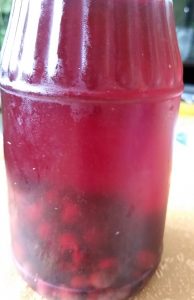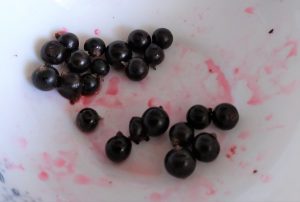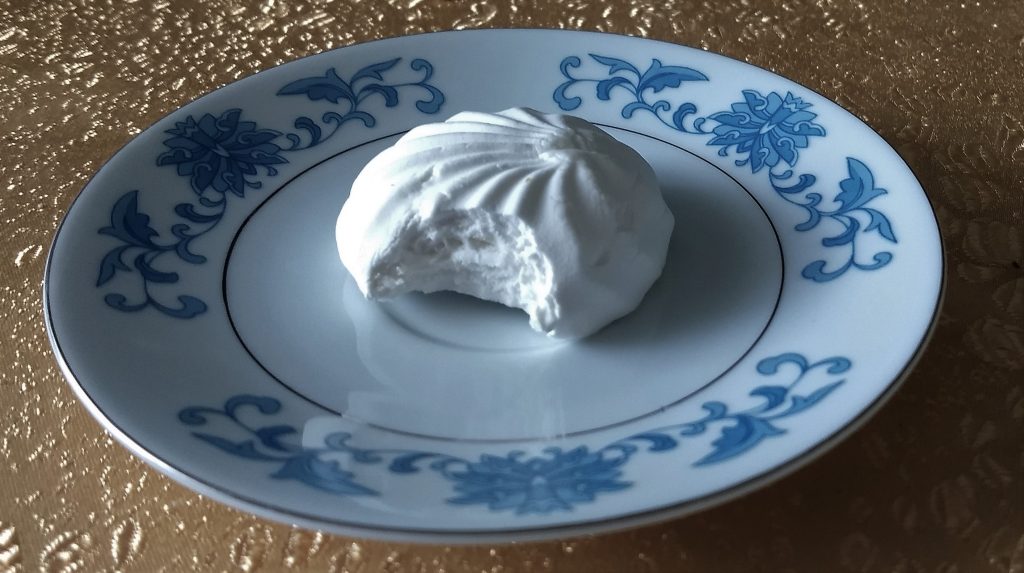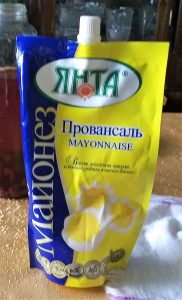Visit to Chita Summer 2018, No. 7 Familiar foods, different ways of enjoying them
It is later in the summer now, and things are being canned and pickled as they are back home. I have benefited from this as a fortunate guest. People keep giving me their stuff: cucumbers and quick summer cucumber salt pickles, compote, varenya, onion greens, lettuce. Plus if we have tea, I seem to get the remains as the fortunate guest, so I’ve also received homemade cake and pie and cookies and sweets.
All this made me think to talk about foods that are familiar to me at home, but are used differently here. I’ll present four of them: compote, varenya, zephyr and mayonnaise.
Compote is fruit or berry drink made by pouring very hot water over fruit or berries with sugar. It is essential canned fruit, but the liquid is the thing, not the fruit. Of the various ways to preserve fruits and berries, this seems to be a favorite: easy, quick, completely fresh and tastes like the fruit, because it is the fruit. It is boiled for long conservation.

Natalia Petrenko’s homemade compote of black currants. The picture at the top is of Elena Pishcherskaya’s black currant compote (long conservation) in her kitchen.
In my experience “compote” at home is about the fruit itself and the liquid is

All that remains of a big bowl of fresh black currants. I wasn’t fast enough…
pretty thick and very sweet and is the treat at the end of eating the fruit. That relationship is reversed here. This compote is made with black currants.
Varenya is jam, but it isn’t exactly jam, and I’m glad to have finally heard that argument among some English students. Our jam is firm and their varenya is usually runny. It is fruit with sugar. Sometimes boiled a little or a lot for long conservation, sometimes just stirred and stirred to dissolve the sugar and then is eaten pretty quickly or else frozen. One in the picture is mashed using a blender.

Varenya from left: Elena Pischerskaya’s boiled black currant; Elena Anisimova’s rhubarb and black currant (blender); Nastya’s , English student (3rd from the right in Post No. 6), strawberry
If eaten with bread and butter, it is sort of dribbled on the bread. But as common as putting it on bread is to just dip into the bowl or jar with a spoon and head directly for the mouth. It’s the best. I mentioned I noted a cultural difference here because we are all licking our spoons clean and then dipping them back into the same jar of varenya, sharing…Germs! When I said that, there was some worry that that bothered me, but it doesn’t at all. But I know some people back home that would drive crazy. In fact, “tea” can be a meal or it can just be sweets, but a jar of varenya typically appears at the end along with some small spoons, even ones with long handles for reaching across the table.
The picture shows strawberry, rhubarb and two ways of preparing black currants. I only knew currants as those small raisins (that I now prefer to regular raisins, myself), but these are plump juicy berries about the size and sort of the appearance of blueberries, though the color is red to black and not blue. The flavor is its own and is really growing on me. I understand the bush is easy to grow and I’m thinking of adding a couple to my yard now! By the way, the leaves of the bush make a great tea and are also used in making pickles.

Is it a cookie? Is it a candy? Looks like meringue but it is close to our marshmallow.
Zephyr (accent on the last syllable) is a cookie/candy that is very popular. It is essentially our marshmallow, but a bit softer and there is something in the flavor that is a bit stronger—not just sweet. They are often flavored and/or coated in chocolate. When I was growing up, marshmallows had a few specific purposes: campfire roasting and ‘Smores and as topping on yams. I should add snitching from the cupboard, too. Here, these are treated as common, but pretty classy, cookies—halfway between cookies and candy.
Mayonnaise. This shocked me back in the first visits here in 1989-1993. I grew up knowing mayo was used for sandwiches with ham or roast beef and tomatoes, etc, for salads like potato salad or cole slaw and as part of creamy style salad dressings. That was about it.

Russian mayonnaise. There seem to be a few types in the store. This is “Provençal”.
The same uses are here, too, but they add a few interesting ones. It is plopped into non-cream soups like borsch or lagman or shchee instead of smetana, their cultured thick cream–against which our sour cream is a poor match if you ask me. It is a standard sauce used with meat dumplings, both Russian (pelmeni) and Buryat (posi). And it is a sauce smeared on baked dishes like chicken or other dishes that may have a sauce on top. The mayo may be spiced, but it can be just on top. And then the dish is baked, the mayo heated and browned. It is a really good idea, though at first a shock to me.
I should mention that Russian mayonnaise is really good. A friend, who shall remain nameless, on visiting the US said that “Hellman’s” is not very good, though she gave “Mrs. Clark’s” her enthusiastic approval. That’s a brand I think is only found in the Midwest. It’s made in Iowa. The stuff in that squeeze packet in the picture is really tasty and very white.
Side note: this squeeze packet container is popular for standard Russian mustard—hot and specific—horseradish—not very hot, but tasty—chili sauce—hot or not. Yesterday a bunch of us went to a really nice Buryat restaurant. I was at the far end of the table and Victor asked what sauces I wanted and lined up these tubes of mustard, chili, horseradish and bottles of soy sauce and ketchup. There was already a dish of mayo that came with the posi and someone’s soup. All these sauces go really well with posi. I went with horseradish.



